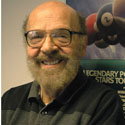 Tips & shafts By George Fels Consulting Editor George Fels has been writing for Billiards Digest since 1980, and his "Tips & Shafts" column is usually our readers' first stop when they crack open the magazine. For better or worse, pool has been his only mistress for 40-plus years.
Archives
Best of Fels
|
|
May: Save the Last Trance for Me May 2011 IN MAKING my dazzling cover debut last fall, my "30 + 1" playing-tips section included this mention: Try chalking your cue with the hand you don't normally use. It was just one of several suggestions for attaining short-term improvement through reasonable change (such as playing rhythm, length of bridge, speed of stroke, etc.).
But the next thing I knew, there was a five-page thread in one of the cue games' best-known online forums as people debated my innocent tip and what was behind it. "How do I get the last two hours of my life back?" queried one poster. Another suggested I had fallen prey to the dreaded "analysis paralysis." But the only reason I reprised that suggestion - I first offered it in 1981 - was, again, that it's a fairly simple way of tapping into both sides of the brain. Which, in turn, is something that has to happen if you hope to achieve the fabled "dead stroke."
The five-part series I wrote on the subject back then (don't worry; I won't get nostalgic on you. All I remember is that The Police were very big, and I didn't have much hair then either) was, to my knowledge, the first writing ever to propose how you might go about achieving the hyper-elusive state. But that series (begun in our July/August '81 issue, if you want specifics; the magazine was published semi-monthly then) didn't make me the first author to tackle that subject. Here's what the great John Grissim had to say, roughly two years before me, in his brilliant book "Billiards: Hustlers & Heroes, Legends & Liars, and The Search for Higher Truth on the Green Felt":
"I moved on to the next shot, feeling my concentration gather effortlessly into focus. My field of vision seemed to encompass the entire table. For the next few minutes I not only did not miss a ball but never gave the possibility a thought. I ran a 23, my highest ever run for money. I felt exhilaration and a kind of muscular certitude that my participation in the act of pocketing balls was as immutable as the laws governing spheres in motion. I lost track of time, of my presence of mind, of the loud rock music blaring over the room's PA speakers. Here was the innermost limit of pure fun. I was lost in the land of dead stroke.
" The trance sensations players describe are identical: bullet-proof concentration, total absorption in the game, self-forgetfulness, a fantastic good feeling and no sense of the passage of time. Sounds like what Eastern mystics have known for years Trance states, of course, may be achieved through any focused activity, especially those in which concentration and physical self-mastery are elements One or two articulate players claim there are rare moments when the play of the game explodes into a transcendent reality with a limitless horizon, rather like having one's skull fall away, leaving free an all-seeing eye. Short of that, one may still have the more commonly experienced sensation of simply being really ON."
As informed as that view is, there's little point in considering who was first to write, or write instructionally, on that subject, between John and me. The fact is, we were both scooped, and by close to 20 years, by the late and immortal Walter Tevis, whose value to our entire industry has long since ceased to be calculable. This is from his peerless "The Hustler," describing the first encounter between Eddie and Fats:
"Then Eddie started winning. He felt it start in the middle of a game, began to feel the sense he sometimes had of being a part of the table and of the balls and of the cue stick. The stroke of his arm seemed to travel on oiled bearings; and each muscle of his body was alert, sensitive to the game and the movement of the balls, sharply aware of how every ball would roll, of how, exactly, every shot must be made someone turned off all the lights except those over the table that they were playing on and the background of Bennington's vanished, leaving only the faces of the crowd around the table, the green of the cloth of the table, and the now sharply etched, clean, black-shadowed balls, brilliant against the green. The balls had sharp, jeweled edges; the cue ball itself was a milk-white jewel and it was a magnificent thing to watch the balls roll and to know beforehand where they were going to roll. Nothing could be so clear or so simple or so excellent to do. And there was no limit to the shots that could be made. Fats' game was brilliant, fantastically good, but Eddie was beating him now, playing an incredible game, a game that he felt he had known all of his life, that he would play when the right time came. There was no better time than this."
Some players, including Hall of Famer Lou Butera, have tried hypnotherapy (Google my old buddy Ryan Elliott if you're interested in that; he specializes in pool players). Others, who shall remain nameless, have turned to chemical warfare of all sorts. And yet picking up mercury with a butter knife is easier than slipping into that damned trance. If the above has you salivating to get to the table, the least I can do after teasing you so is to offer two more possible techniques that might help you enter the magic kingdom:
1) Include a few (say, five to 10) opposite-handed shots in your practice routine. Vary when you shoot them (first, last, interspersed, etc.), and keep them easy.
2) Set a row of three (more if you like) balls in the exact center of the table, the long way. Using draw, pocket them in sequence in the same side pocket.
I make no guarantees, naturally; I shall indemnify no losses. But a fortunate segment of you will soon wonder, "Now how did that old coot know that?" |





